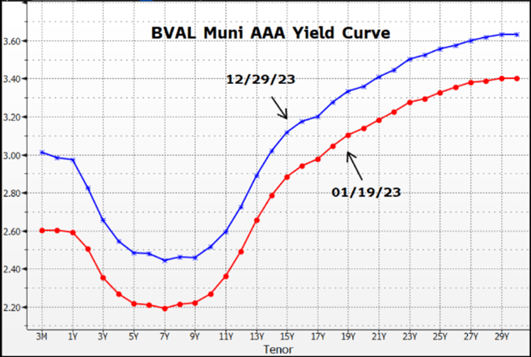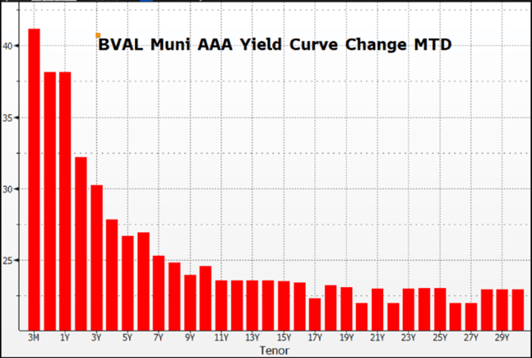Silent Nights, Strong Numbers: GDP Pops, S&P Hits Highs Trading during the Christmas holiday week was subdued, with staffing shortages adding to the muted tone. Still, a few key data releases mana...
Market Commentary: Week of January 22, 2024
This January, the municipal market followed the lead of the weather patterns throughout the U.S. with a colder than expected reception by market participants. The oft-anticipated “January Effect” has failed to come to fruition in 2024. In hindsight, following the extreme outsized move from the October high in rates and strong move below the 4% threshold in mid-December by 10-Year Treasury, it was just a matter of time for the markets to collect themselves and settle down. Conflicting supply and demand dynamics are pushing and pulling the market in different directions. The demand for paper should be more solid than we observed throughout the month, with fund flows finally reversing a significant multi-month slide (+$2 bln week of 01/10) and over +$33 bln in anticipated reinvestment monies in January. Ratios as a percentage of U.S. Treasuries, however, remained low, disincentivizing investors from putting cash to work in a relatively expensive market environment. As demonstrated below, (per the BVAL AAA curve), municipal rates moved steadily higher on the month – about 20-25 basis points along much of the curve and 30-40 bps on the front-end.


Source: Bloomberg
Looking forward throughout 2024, we expect new issue supply to stop the slide it experienced in recent years and produce a $400-$410 bln figure ($391 bln in 2022 and $381 bln in 2023). Demand should remain steady, with yields well above the lows experienced during the Feds Zero Interest Rate Policy (ZIRP). We anticipate investors will continue to seek the relative safety and opportunity provided within the municipal market, especially within the managed account base of participants. Much of the expectation for interest rate forecasting remains closely tied to Fed policy guidance and rhetoric. Arguably, we believe the market became slightly overexuberant in recent months regarding an expectation for quicker and greater Fed cuts. Though some cuts can be reasonably expected to occur in 2024, the Fed continues to remain cautious about its approach to managing guidance.
Definitions:
An index is unmanaged and not available for direct investment. Definitions sourced from Bloomberg.
The Bloomberg Barclays Global Aggregate Negative Yielding Debt Market Value Index represents the portion of the Bloomberg Barclays Global Aggregate Index that measures the aggregate value of global debt with a negative yield. • The S&P 500® is widely regarded as the best single gauge of large-cap U.S. equities and serves as the foundation for a wide range of investment products. The index includes 500 leading companies and captures approximately 80% coverage of available market capitalization. • The NASDAQ Composite Index is a broad-based capitalization-weighted index of stocks in all three NASDAQ tiers: Global Select, Global Market and Capital Market. The index was developed with a base level of 100 as of February 5, 1971.• The Cboe Volatility Index® (VIX) is a calculation designed to produce a measure of constant, 30-day expected volatility of the US stock market, derived from real-time, mid-quote prices of weekly S&P 500® Index (SPX) call and put options with a range of 23 to 37 days to expiration.• The ICE BofA MOVE Index is a yield curve weighted index of the normalized implied volatility on 1-month Treasury options. It is the weighted average of implied volatilities on the CT2 (Current 2 Year Government Note), CT5 (Current 5 Year Government Note), CT10 (Current 10 Year Government Note), and CT30 (Current 30 Year Government Note), with weights 0.2/0.2/0.4/0.2 respectively.• The Markit CDX North America Investment Grade Index is composed of 125 equally weighted credit default swaps on investment grade entities, distributed among 6 sub-indices: High Volatility, Consumer, Energy, Financial, Industrial, and Technology, Media & Tele-communications. Markit CDX indices roll every 6 months in March & September. • The Markit CDX North America High Yield Index is composed of 100 non-investment grade entities, distributed among 2 sub-indices: B, BB. All entities are domiciled in North America. Markit CDX indices roll every 6 months in March & September. • The U.S. Dollar Index (USDX) indicates the general international value of the USD. The USDX does this by averaging the exchange rates between the USD and major world currencies. Intercontinental Exchange (ICE) US computes this by using the rates supplied by some 500 banks.
Investing involves certain risks, including possible loss of principal. You should understand and carefully consider a strategy’s objectives, risks, fees, expenses, and other information before investing. The views expressed in this commentary are subject to change and are not intended to be a recommendation or investment advice. Such views do not take into account the individual financial circumstances or objectives of any investor that receives them. All indices are unmanaged and are not available for direct investment. Indices do not incur costs including the payment of transaction costs, fees, and other expenses. This information should not be considered a solicitation or an offer to provide any service in any jurisdiction where it would be unlawful to do so under the laws of that jurisdiction. Past performance is no guarantee of future results.
© 2021 SWBC. All rights reserved. Securities offered through SWBC Investment Services, LLC, a registered broker/dealer. Member FINRA & SIPC. Advisory services offered through SWBC Investment Company, a Registered Investment Advisor, registered as such with the US Securities & Exchange Commission. SWBC Investment Services, LLC is under separate ownership from any other named entity. SWBC Investment Services, LLC a division of SWBC, is a nationwide partnership of advisor.
Related Categories
Capital MarketsChristopher Brigati, Chief Investment Officer — Managing Director
Prior to joining SWBC, Brigati was Senior Vice President, Managing Director of Municipal Investments at Valley National Bank. With over 25 years of experience primarily in the municipal market, he is a recognized thought leader in the fixed-income markets and is a regular contributor with appearances on Bloomberg Television and Radio. He has authored numerous economic commentaries and his insights have been featured in leading financial media publications, including The Bond Buyer, The Wall Street Journal, and Bloomberg. Brigati has also been an active participant with the Bond Dealers of America (BDA) trade association, advocating regulators and legislators on Capitol Hill on behalf of the broker-dealer community. Before joining Valley National Bank, he served as Managing Director and Head of Municipal Trading at Advisors Asset Management, Inc. (AAM). Before that, he had a long career at Morgan Stanley where he served as Managing Director and Head of Wealth Management Municipal Trading for eight years. Brigati holds a bachelor’s degree from The State University of New York at Albany School of Business. He is registered for Series 3, 4, 7, 24, 53, and 63.

Let Us Know What You Thought about this Post.
Put your Comment Below.